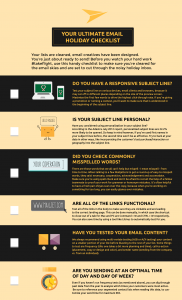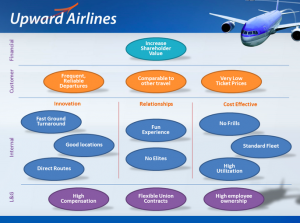
Years ago, optimizing your internal linking was often referred to as “PageRank sculpting” – a term and technique now considered ancient and of no importance, by some.
Pagerank Sculpting…
The idea was that you could affect how your Google PageRank was distributed around your pages. Some of those thoughts were correct: link more and more prominently to pages that matter, less and less prominent to pages that don’t.
Other ideas turned out to be partial hogwash. Adding “nofollow” to links could make the page linked to less important but the page doing the linking wasn’t increasing it’s PageRank; nofollow or not, every links “substracts” from the amount of PageRank a page can pass.
…versus Relevance Sculpting
The focus on PageRank meant people missed the greater picture for an easy optimization opportunity.

Optimizing your internal linking is not about nofollowing internal links to “privacy policy” and similar but rather about looking at the core of your website navigation and internal links structure – i.e. if you are linking too much to “low quality and thin content pages” versus “real content pages”.
The answer to this is hard to give unless you run any actual analysis on it.
How A1 Website Analyzer Can Help
A you know, I’m a big fan of the SEO audit tool & website crawler A1 Website Analyzer. Since its first release in 2005 it features an algorithm suitable to analyze internal linking.
The program uses multiple steps to calculate the relative importance of a pages:
- All pages get a count for how many internal incoming links they have pointing to them.
- All pages get a count for how many outgoing links they have.
- All pages get their average “link value” calculated – e.g. 50 incoming divided by 25 outgoing gives a link value of 2.
- All pages get scored accordingly to how much “link value” / “link juice” they have pointing at them. By default:
- Nofollow links are discounted completely.
- Repeated links to the same URL transfer less and less value.
- URLs that point to another using a redirect or canonical instruction transfer all their incoming link value.
- Nofollow links are discounted completely.
- The values are converted using a logarithm. As an example, here is Log2:
Log_Base2(10000) = 13.29 as 2^13.29 ~ 10000.
Log_Base2(1000) = 9.97 as 2^9.97 ~ 1000.
Log_Base2(100) = 6.64 as 2^6.64 ~ 100.
Log_Base2(50) = 5.64 as 2^5.64 ~ 50.
- And finally these values are then scaled to range 0-10 using linear interpolation, giving a nice “importance” number for each page.
Tutorial
When you first start A1 Website Analyzer, you can simply use its default configuration.
Simply type in your website domain address and hit the “Start scan” button.
When the site crawl has finished, select the “Analyze website data” tab.
Select the appropriate columns in top menu “View > Data Columns > Importance ranks” and “View > Data Columns > URL references” or use he columns button ![]()
Note: You can also use the “quick report” button ![]() and choose “Show only page URLs – and all relevant SEO information”
and choose “Show only page URLs – and all relevant SEO information”
You then get a result looking much like this:
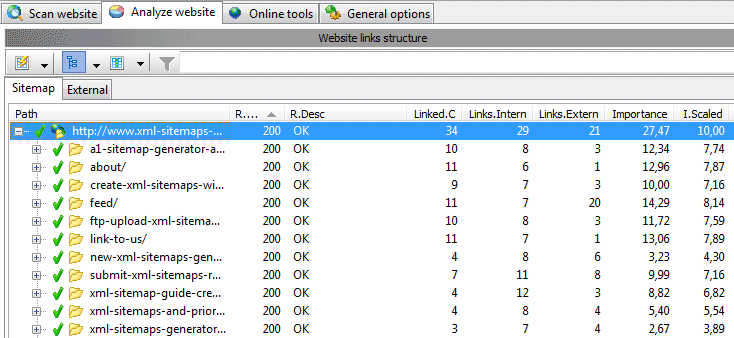
After this you can:
- Choose if you want to view URLs in “list” or “tree” mode.
- Sort on the various columns.
- Dive into further details checking the specific links.
- Export the results to a spreadsheet.
If you choose to export:
Whatever columns and data is shown is what gets exported to CSV / Excel format. You can access other export options (e.g. if you want to include headers or use a different character encoding format than the default) in
the main top program menu “Options > Program options > Data export / import.
Analysis & Quick Wins
The larger the site, the more a link analysis is needed.
The larger the site, the more work fixing internal linking is.
Work = resources. Whatever you do for a site must pay itself back, fast.
Here are some quick-wins you can get.
Linking To Missing Pages
404 Not Found pages cannot pass any ranking values. Search engines don’t even look at what’s on the page. So if you’re linking to pages that have gone missing, your throwing internal voting power away.

- Filter for HTML pages
- That return a 404 Not Found status codecode
- Sort by Importance Scaled
You can see both the number of pages linking to these pages and a number of those specific URL’s. If it’s a handful, just fix the links. Is it a whole lot and there’s no quick templated way to fix it? Bring the missing URL back to life!
Redirecting To Missing Pages
Most times when an SEO technician checks a header status what they’re seeing is the very first header response. If that’s a 301, hey, we all know that’s good.
But redirects become redirect chains over time, not always ending where we want them to.

- Filter for HTML pages
- That return a 301 Permanently Moved status code
- The filter on Redirect Response, looking for 404 Not Found responses
- Sort by Importance Scaled
Same fixes as under the missing pages section, above.
Important Pages
- Filter for HTML pages
- That exist (200 OK Found status code)
- Sort by Importance Scaled

Some pages you don’t care about will almost always be in your top 10 because every frigging page on a site links to them: site map, privacy policy, contact us, about. That kind of stuff.
But what’s wrong in the above report? Shouldn’t the home page be the most important page? Shouldn’t it at least appear in the top 10?
We see tag and category pages among the most important. That’s not a bad thing in and of itself. Maybe this is what you wanted? If not, you’re options are changing how you link to those pages, considering “noindex” (in the head, of course), or running with it and optimizing those pages into true landing page performance class A pages.
The Solutions page, the place where stuff is being sold, comes out 8th. Was that how you meant it to be? No? What can you do to boost the internal linking of that page? Or should you go the other way and demote some of the linking to the other pages?
Pages With Boosting Power
How about finding pages you can use to link from in order to boost other pages?
There are many ways to go about this. This is one of them.
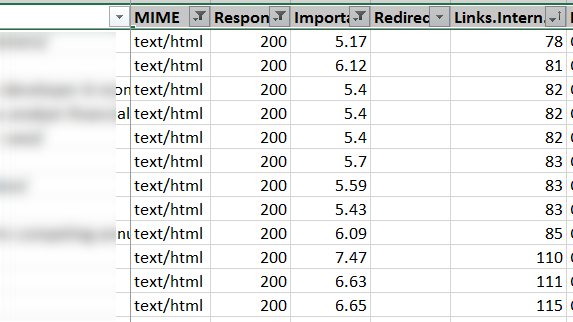
- Filter for HTML pages
- That exist (200 OK)
- Sort by Links Internal Count (how many times does this page link out already?)
- Filter or sort your Importance Scaled as you want. Here I asked Excel to list any page with a score between 5 and 8. Why not 9 and 10? Because those tend to be my main product pages; I don’t always want those used but for the top of the line linking.
By looking at my list I can find strong pages with the least amount of links on them already: more for us to go about!
Are You Linking The Right Way
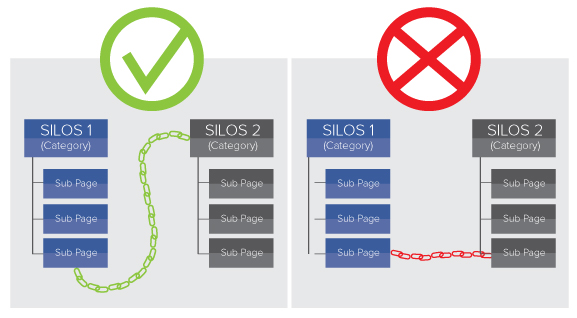
First check if your top product category pages are getting the links they deserve:
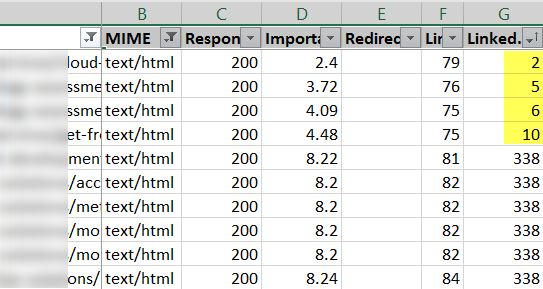
- Filter for HTML pages
- That exist
- Filter Path using whatever word appears in your URL structure: products, solutions, services, etc.
- Sort by Linked Count, descending
Most top product pages on this site get all the link love they deserve. But what about those highlighted ones? Are they subpages from a top product page? If so, would they really start to rank linked minimally like this? What does the (link) importance that we place on these pages tell us about their perceived importance? What would Google think?
How To Easily Optimize Internal Linking With A1 Website Analyzer
The post How To Easily Optimize Internal Linking With A1 Website Analyzer appeared first on Search Engine People Blog.
Search Engine People Blog(68)
Report Post

